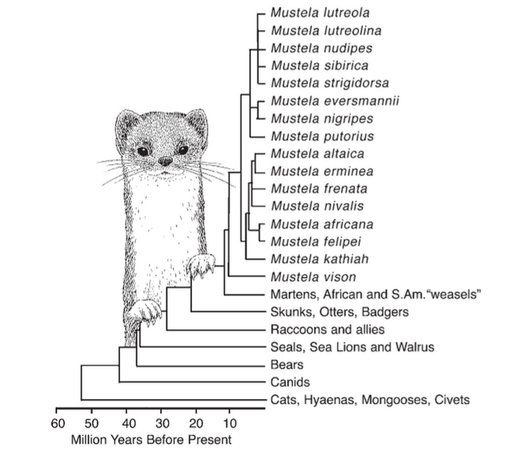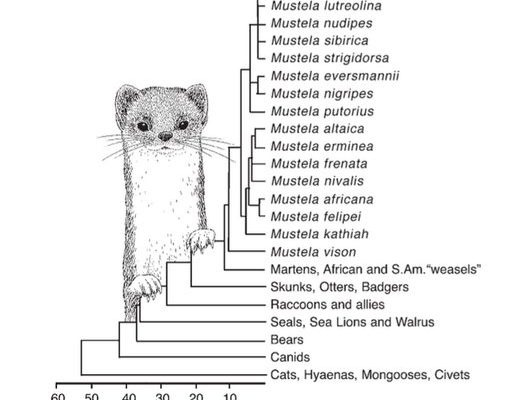
Here’s the thing: weasels are not just tiny predators; they’re part of a larger family known as Mustelidae. This family includes ferrets, otters, and badgers, each with its own unique story. Understanding the evolutionary history of the weasel can give us insight into their behaviors, habitats, and even their future. So, grab that cup of coffee, and let’s explore the wild world of weasels!
The Origins of Weasels
Weasels belong to a family called Mustelidae, which has been around for a long time—over 30 million years! They originally evolved from a group of carnivorous mammals during the late Eocene epoch. Picture a world filled with ancient forests and strange creatures; this is where the ancestors of weasels began their journey. These early mammals were small, agile predators, well adapted to hunt small animals.
As weasels evolved, they developed distinct physical traits that helped them thrive. For instance, their slender bodies enable them to dart into tight spaces, making it easy to follow prey into burrows. Their sharp teeth and claws evolved to help them catch and eat small rodents, birds, and even insects. You might be wondering why they didn’t just stay the same; well, evolution is all about adapting to survive.
Over time, weasels diversified into different species, each uniquely suited to its environment. Today, there are multiple weasel species found across the globe, from the common stoat to the European polecat. Each of these species has its own story to tell, shaped by the challenges and opportunities of its habitat.
Physical Adaptations and Survival Strategies
Let’s talk about some of the cool physical features that help weasels survive. One of their most notable traits is their **agility**. Weasels have long, flexible bodies that allow them to squeeze through narrow spaces, which is pretty handy when evading predators or sneaking up on prey. Think of them as the acrobats of the animal kingdom!
Weasels also have a keen sense of hearing and smell. This sharpness helps them detect the slightest movement in the underbrush, whether it’s a potential meal or a threat. They are known for being fierce hunters despite their small size. Just imagine a tiny weasel taking down a much larger rabbit—it’s a testament to their skill and determination.
Another fascinating adaptation is their seasonal fur changes. For instance, the ermine, or stoat, transforms from a brown coat in summer to a white one in winter. This change not only helps with camouflage but also keeps them warm during the colder months. It’s like wearing a new outfit that’s perfect for the weather!
Weasels in Ecosystems
Weasels play a vital role in their ecosystems. As predators, they help keep populations of small mammals in check. This balancing act is crucial for maintaining the health of their environments. Without weasels, certain species might become overpopulated, leading to a cascade of ecological issues.
They also serve as prey for larger animals, such as owls and foxes. This predator-prey relationship is essential for the food web. You can think of it like a game of musical chairs—everyone has their role, and when one group is removed, it can lead to chaos.
Additionally, weasels are often seen as indicators of a healthy ecosystem. Their presence can signify that the environment has the right balance of prey and habitat. If weasels start to disappear, it might be a warning sign that something is off in that ecosystem.
Human Interaction and Perception
Throughout history, humans have had a mixed relationship with weasels. In some cultures, they are viewed as pests because they can raid chicken coops or attack small livestock. You may have even heard stories of cunning weasels outsmarting farmers. However, there’s another side to the tale.
In other cultures, weasels are celebrated for their agility and hunting prowess. They’ve been featured in folklore and mythology, symbolizing cleverness and resourcefulness. This contrast highlights how our perceptions can shift dramatically based on context and experience.
Today, conservation efforts are underway to protect various weasel species that face threats from habitat loss and climate change. It’s important to remember that these small creatures contribute to our world in significant ways, and by protecting them, we’re also looking out for the health of our ecosystems.
Challenges and Conservation Efforts
As the world changes due to human activities, so do the challenges facing weasels. Habitat destruction, climate change, and pollution are just a few of the issues that endanger these little mammals. For example, as forests are cleared for agriculture, weasels lose their homes and food sources, leading to declining populations.
Conservationists are stepping up to address these challenges. They implement strategies like creating wildlife corridors to connect fragmented habitats, ensuring that weasels can move freely and find mates without crossing dangerous roads. These efforts aim to maintain genetic diversity, which is crucial for the long-term survival of any species.
It’s not just about saving weasels; it’s about preserving the intricate web of life that supports them. By protecting weasels, we’re also advocating for the health of entire ecosystems, proving that even the smallest creatures can have a big impact.
The Future of Weasels
Looking ahead, the future of weasels is uncertain. As climate change continues to reshape our world, weasels may have to adapt quickly or face extinction. They’re already shifting their habitats in response to temperature changes, which could alter their hunting patterns and interactions with other species.
However, there’s hope. With increased awareness and dedicated conservation efforts, weasels can continue to thrive. Education plays a massive role here—by understanding their importance, we can work together to develop sustainable practices that protect both weasels and their environments.
Ultimately, the evolutionary history of the weasel is a story of resilience and adaptation. These fascinating creatures remind us of the intricate connections between life forms and the importance of playing our part in preserving the natural world.
The evolutionary journey of the weasel is a captivating tale that showcases the wonders of nature. From their ancient roots to their clever adaptations, weasels have proven to be resilient survivors. By appreciating their role in ecosystems and supporting conservation efforts, we can ensure that these small predators continue to thrive for generations to come.
So, the next time you spot a weasel darting through the grass, take a moment to appreciate its rich history and incredible adaptations. It’s a little reminder of the complexity and beauty of the natural world around us.

